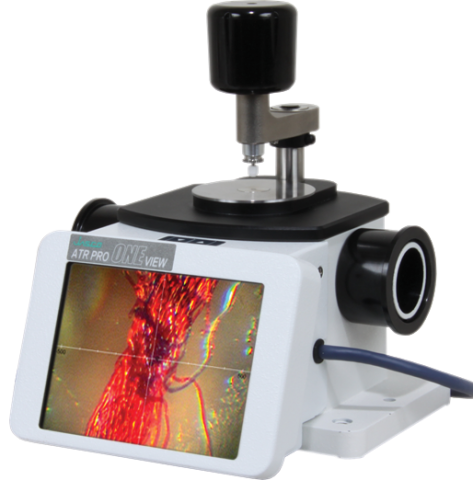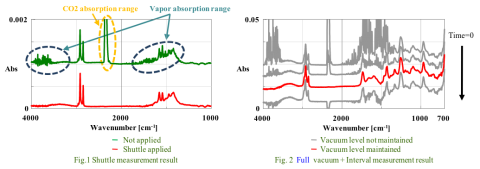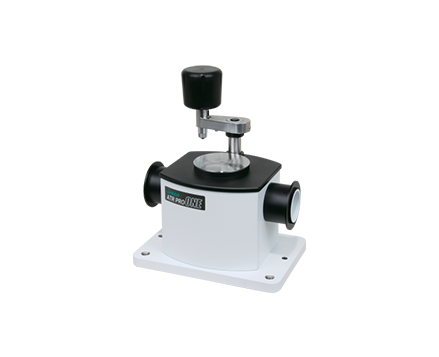Reduction of Noise from Water Vapor and Carbon Dioxide
February 26, 2024
Introduction

Atmospheric water vapor (H2O) and carbon dioxide (CO2) are strongly absorbed in the infrared region of the electromagnetic spectrum. They can interfere with the analysis and detection of wake sample peaks due to the additional peaks in the spectrum caused by H2O and CO2. To reduce the effect of the background peaks associated with H2O and CO2 it is important to maintain the concentration of water vapor and CO2 at the same level when measuring the background and the sample. In this application note, we would like to introduce a couple of measurement options to minimize the effects of water vapor and CO2, including “Sample Shuttle Measurement” and “Purge and Vacuum”.
Experimental
1. Sample Shuttle Measurement
In this method, the sample is placed in a sample shuttle (with background and sample positions) in the sample compartment, which allows the background and sample measurements to be made without opening the sample compartment lid. Using a sample shuttle allows measurements to be made without the effect of changes in the atmosphere. Improved spectra are obtained with reduced background peaks from water vapor and CO2 by making the measurements one after another in short succession. This is an easy-to-use and effective method for transmission measurements.
2. Purge and Vacuum with Interval Measurement Program
This is useful for transmission measurements and for use with sampling accessories, such as Attenuated Total Reflectance (ATR) or Diffuse Reflectance Infrared Fourier-Transform Spectroscopy (DRIFTS). Both purge and vacuum reduce the amount of water vapor and CO2 in the instrument by removing them from the optical path. When using this method, the level of purge or evacuation has to be constantly maintained between background and sample measurements. Purge or vacuum is useful when using the Interval Measurement Program to provide continuous measurement of a process without the effects of changing water vapor or CO2 levels. The data obtained using purge or vacuum under constant conditions allows much easier acquisition of spectra without the effects of water vapor and CO2.
Keywords
280-SO-0006, ATR PRO ONE,
Results
Measurement examples obtained using methods 1 and 2 above are detailed below.
Method 1 was used to measure a thin film of calcium stearate on the surface of a CaF2 plate. Figure 1 shows the results of measurement with and without using the sample shuttle. When measuring peaks with low absorption, such as thin films, water vapor and CO2 greatly influence the acquired spectrum. When using the sample shuttle, it can be observed that the effects of water vapor and CO2 are significantly decreased.
Method 2 was used to measure a vinyl chloride film using a full vacuum system with an ATR accessory. The results of interval measurement are displayed in Figure 2. It can be observed that the data where the level of vacuum was not maintained shows the effects of water vapor and CO2. In this case, the measurement is usually repeated after releasing the vacuum. During interval measurement, it is easy to continuously measure spectra without the effects of water vapor and CO2 using a full vacuum FTIR spectrometer.

Figure 2 (Right). Full Vacuum + Interval Measurement Result
Featured Products:

Reduction of Noise from Water Vapor and Carbon Dioxide
Introduction

Atmospheric water vapor (H2O) and carbon dioxide (CO2) are strongly absorbed in the infrared region of the electromagnetic spectrum. They can interfere with the analysis and detection of wake sample peaks due to the additional peaks in the spectrum caused by H2O and CO2. To reduce the effect of the background peaks associated with H2O and CO2 it is important to maintain the concentration of water vapor and CO2 at the same level when measuring the background and the sample. In this application note, we would like to introduce a couple of measurement options to minimize the effects of water vapor and CO2, including “Sample Shuttle Measurement” and “Purge and Vacuum”.
Experimental
1. Sample Shuttle Measurement
In this method, the sample is placed in a sample shuttle (with background and sample positions) in the sample compartment, which allows the background and sample measurements to be made without opening the sample compartment lid. Using a sample shuttle allows measurements to be made without the effect of changes in the atmosphere. Improved spectra are obtained with reduced background peaks from water vapor and CO2 by making the measurements one after another in short succession. This is an easy-to-use and effective method for transmission measurements.
2. Purge and Vacuum with Interval Measurement Program
This is useful for transmission measurements and for use with sampling accessories, such as Attenuated Total Reflectance (ATR) or Diffuse Reflectance Infrared Fourier-Transform Spectroscopy (DRIFTS). Both purge and vacuum reduce the amount of water vapor and CO2 in the instrument by removing them from the optical path. When using this method, the level of purge or evacuation has to be constantly maintained between background and sample measurements. Purge or vacuum is useful when using the Interval Measurement Program to provide continuous measurement of a process without the effects of changing water vapor or CO2 levels. The data obtained using purge or vacuum under constant conditions allows much easier acquisition of spectra without the effects of water vapor and CO2.
Results
Measurement examples obtained using methods 1 and 2 above are detailed below.
Method 1 was used to measure a thin film of calcium stearate on the surface of a CaF2 plate. Figure 1 shows the results of measurement with and without using the sample shuttle. When measuring peaks with low absorption, such as thin films, water vapor and CO2 greatly influence the acquired spectrum. When using the sample shuttle, it can be observed that the effects of water vapor and CO2 are significantly decreased.
Method 2 was used to measure a vinyl chloride film using a full vacuum system with an ATR accessory. The results of interval measurement are displayed in Figure 2. It can be observed that the data where the level of vacuum was not maintained shows the effects of water vapor and CO2. In this case, the measurement is usually repeated after releasing the vacuum. During interval measurement, it is easy to continuously measure spectra without the effects of water vapor and CO2 using a full vacuum FTIR spectrometer.

Figure 2 (Right). Full Vacuum + Interval Measurement Result
Keywords
280-SO-0006, ATR PRO ONE,

 Download This Application
Download This Application
